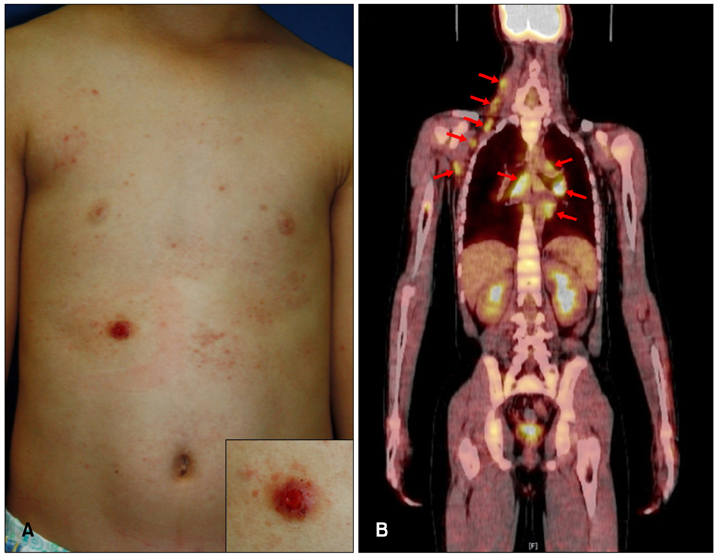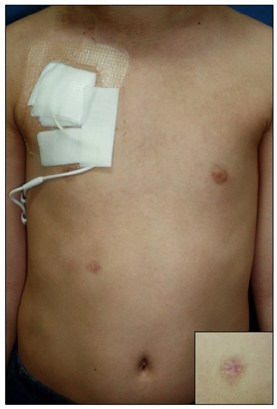Ann Dermatol.
2016 Jun;28(3):371-374. 10.5021/ad.2016.28.3.371.
CD30-Positive Anaplastic Lymphoma Kinase-Negative Systemic Anaplastic Large-Cell Lymphoma in a 9-Year-Old Boy
- Affiliations
-
- 1Department of Dermatology, Hanyang University College of Medicine, Seoul, Korea. drko0303@hanyang.ac.kr
- KMID: 2164646
- DOI: http://doi.org/10.5021/ad.2016.28.3.371
Abstract
- Anaplastic large-cell lymphoma (ALCL) is a CD30-positive T-cell/null-cell lymphoma that is clinically classified into either primary cutaneous ALCL or systemic ALCL (S-ALCL) sub-types. Because 90% of childhood S-ALCL cases are anaplastic lymphoma kinase (ALK)-positive, there is a lack of data on ALK-negative S-ALCL cases among pediatric patients. Herein, we report a rare case of ALK-negative S-ALCL in a 9-year-old Korean boy who initially presented with itchy erythematous maculopapules and an erosive nodule on the trunk area. We emphasize the need of high index of suspicion of an underlying malignant disease in the presence of refractory eczematous lesions.
MeSH Terms
Figure
Reference
-
1. Sandlund JT, Pui CH, Roberts WM, Santana VM, Morris SW, Berard CW, et al. Clinicopathological features and treatment outcomes of children with large cell lymphoma and t(2;5)(p23;q35). Blood. 1994; 84:2467–2471.
Article2. Wright D, McKeever P, Carter R. Childhood non-Hodgkin lymphomas in the United Kingdom: findings from the UK children's cancer study group. J Clin Pathol. 1997; 50:128–134.
Article3. Lowe EJ, Gross TG. Anaplastic large cell lymphoma in children and adolescents. Pediatr Hematol Oncol. 2013; 30:509–519.
Article4. Stein H, Foss HD, Dürkop H, Marafioti T, Delsol G, Pulford K, et al. CD30(+) anaplastic large cell lymphoma: a review of histopathologic, genetic and clinical features. Blood. 2000; 96:3681–3695.5. Hwang IG, Yoo KH, Lee SH, Park YH, Lim TK, Lee SC, et al. Clinicopathologic features and treatment outcomes in malignant lymphoma of pediatric and young adult patients in Korea: comparison of korean all-ages group and Western younger age group. Clin Lymphoma Myeloma. 2007; 7:580–586.
Article6. Burkhardt B, Zimmermann M, Oschlies I, Niggli F, Mann G, Parwaresch R, et al. The impact of age and gender on biology, clinical features and treatment outcome of non-Hodgkin lymphoma in childhood and adolescence. Br J Haematol. 2005; 131:39–49.
Article7. Kocabaş E, Türel Ermertcan A, Akinci S, Temiz P, Gündüz K. Primary cutaneous CD30-positive anaplastic large cell lymphoma in a 16-year-old girl. Int J Dermatol. 2012; 51:1353–1358.
Article8. Kim HS, Sim SJ, Kim DC, Kim JS, Song KH, Kim KH. A case of ALK-negative systemic anaplastic large cell lymphoma. Ann Dermatol. 2004; 16:125–131.
Article9. Oschlies I, Lisfeld J, Lamant L, Nakazawa A, d'Amore ES, Hansson U, et al. ALK-positive anaplastic large cell lymphoma limited to the skin: clinical, histopathological and molecular analysis of 6 pediatric cases. A report from the ALCL99 study. Haematologica. 2013; 98:50–56.
Article10. Ju E, Adigun C, Dunphy C, Gold S, Morrell DS. Anaplastic large cell lymphoma: an unusual presentation in a 7-year-old girl. Pediatr Dermatol. 2012; 29:498–503.
Article11. ten Berge RL, Oudejans JJ, Ossenkoppele GJ, Meijer CJ. ALK-negative systemic anaplastic large cell lymphoma: differential diagnostic and prognostic aspects--a review. J Pathol. 2003; 200:4–15.
Article12. Le Deley MC, Reiter A, Williams D, Delsol G, Oschlies I, McCarthy K, et al. Prognostic factors in childhood anaplastic large cell lymphoma: results of a large European intergroup study. Blood. 2008; 111:1560–1566.
Article13. Brugières L, Quartier P, Le Deley MC, Pacquement H, Perel Y, Bergeron C, et al. Relapses of childhood anaplastic large-cell lymphoma: treatment results in a series of 41 children--a report from the French Society of Pediatric Oncology. Ann Oncol. 2000; 11:53–58.
Article14. Savage KJ, Harris NL, Vose JM, Ullrich F, Jaffe ES, Connors JM, et al. ALK-anaplastic large-cell lymphoma is clinically and immunophenotypically different from both ALK+ ALCL and peripheral T-cell lymphoma, not otherwise specified: report from the international peripheral T-Cell lymphoma project. Blood. 2008; 111:5496–5504.
Article15. Wang YF, Yang YL, Gao ZF, Zhou CJ, Gregg X, Shi YF, et al. Clinical and laboratory characteristics of systemic anaplastic large cell lymphoma in Chinese patients. J Hematol Oncol. 2012; 5:38.
Article16. Mori T, Kiyokawa N, Shimada H, Miyauchi J, Fujimoto J. Anaplastic large cell lymphoma in Japanese children: retrospective analysis of 34 patients diagnosed at the National Research Institute for Child Health and Development. Br J Haematol. 2003; 121:94–96.
Article
- Full Text Links
- Actions
-
Cited
- CITED
-
- Close
- Share
- Similar articles
-
- A Case of CD30 (+)/ALK (-) Systemic Anaplastic Large Cell Lymphoma
- A Case of CD 30+/ALK− Primary Systemic Anaplastic Large Cell Lymphoma Presenting a Sporotrichoid Pattern
- Ki-I Lymphoma In a Young Adult
- A Case of CD30 Positive ALK-Negative Systemic Anaplastic Large Cell Lymphoma Involving Bone Marrow
- A Case of Primary Cutaneous Anaplastic Large Cell Lymphoma on the Dorsum of the Hand




